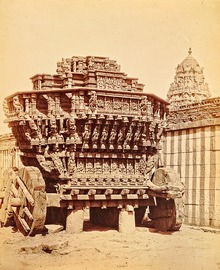


A juggernaut (/ˈdʒʌɡərnɔːt/ ),[1] in current English usage, is a literal or metaphorical force regarded as merciless, destructive, and unstoppable.
This English usage originates in the mid-nineteenth century. Juggernaut is the early rendering in English of Jagannath, an important deity in the Hindu traditions of eastern and north-eastern India. The meaning originates from the Hindu temple cars, which are chariots, often huge, used in processions or religious parades for Jagannath and other deities, the largest of which, once set into motion, are difficult to stop, steer or control by humans, on account of their massive weight.
Since the Middle Ages, Europeans had been fascinated by accounts of the Ratha Yatra (lit. 'temple car procession') at Puri, which claimed that pilgrims threw themselves under the temple cars. However, by 1825 it was said: "That excess of fanaticism which formerly prompted the pilgrims to court death by throwing themselves in crowds under the wheels of the car of Jaganath, has happily long ceased".[2]
- ^ Jones, Daniel (2003) [1917], Peter Roach; James Hartmann; Jane Setter (eds.), English Pronouncing Dictionary, Cambridge: Cambridge University Press, ISBN 3-12-539683-2
- ^ OED, "Juggernaut":1